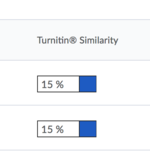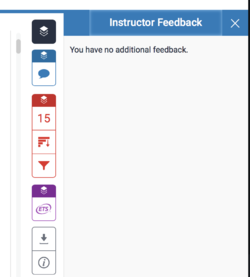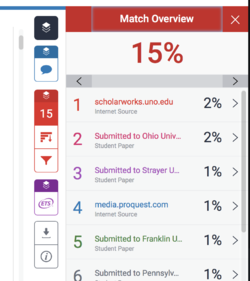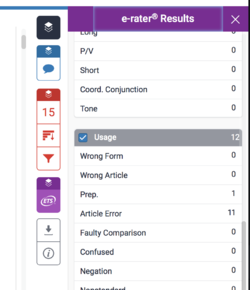Draft:Submit your work to Turnitin
About this article
This article includes an overview of the Turnitin tools, known collectively as Turnitin Feedback Studio, available at WSU. It is intended for all students.
What Turnitin does
WSU has a license to Turnitin's Feedback Studio. Feedback Studio allows the professor to quickly and easily perform the following operations:
- Check for potential plagiarism
Turnitin checks the students paper against billions of web pages and millions of student papers and scholarly works for possible plagiarism. Results are found quickly and shown to the professor in an easy-to-understand way. Turnitin can parse the following file types:- Microsoft Word (.doc / .docx)
- OpenOffice Text (.odt)
- Google Docs via Google Drive (.gdoc files are NOT acceptable)
- WordPerfect (.wpd)
- PostScript (.ps/.eps)
- Adobe PDF
- Microsoft PowerPoint (.pptx, .ppt, .ppsx, and .pps)
- Microsoft Excel (.xls and .xlsx)
- HTML
- Rich text format (.rtf)
- Plain text (.txt)
- Hangul Word Processor file (.hwp)
- Check grammar, spelling, usage, mechanics, and style
Feedback Studio checks for many of the most common writing errors and flags them automatically. - Parse for common writing problems
Common writing issues like run-on sentences, awkward wording, citation issues, and much more are automatically found and flagged. - Use drag-and-drop comments
No needs to retype comments you use often, just drag and drop them from the comment gallery. - Leave voice comments
Easier and faster than typing, voice comments are more personal and help to reenforce the personal connection between the professor and the students. - Grade by rubric
Create writing rubric in Turnitin and give fast, consistent comments to the students in your class.
Turnitin integrates into Brightspace so there is no need to jump between applications during the assessment process.
Viewing your feedback
Turnitin generates reports on similarity to other web pages, articles, and papers in its data warehouse. It also includes information on grammar and word usage. Your professor uses these reports to assist in the assessment of your work.
At the professor's discretion, these reports may be available to you to view as well. If they are, you will see a column on the Assignments page entitled Turnitin Similarity, like the example at right.
The percentage in the box (in this case 15% for each of two submissions) indicates the amount of your submission that was found to be similar to other works found in Turnitin's database. There could potentially be a percentage box after every submission if more than one submission was made and run through Turnitin.
Your professor will look at the report and determine which, if any, of the areas of similarity are significant.
If you wish to see the report, click on the percentage and you will be sent to a Turnitin page with a report on your paper and the information your professor has received. Your paper will appear in the largest part of the display (on the left) and a thin toolbar will appear on the right edge of the display. You submission will include notes and annotations throughout, many generated by Turnitin and some inserted by your professor.
Viewing instructor feedback
Toward the top of the toolbar is a button with a talking bubble. This is the control for viewing instructor feedback in Turnitin.
Clicking the talking bubble will cause the toolbar to slide to the left and a listing of any feedback your professor added in Turnitin will appear. In the example at right, the professor did not add feedback in Turnitin, so the feedback pane is empty.
In some cases, your professor will include feedback in the Turnitin report. In other cases, feedback will appear in Brightspace. It is your professor's personal preference.
Viewing found matches
About a third of the way from the top the toolbar is a button with a number in it. That number will be the same as the percentage value presented on the Assignments page. Clicking on the number will produce a display of papers, articles and websites that had phrases and sentences that match text in your paper.
In the example at right, clicking the "15" displays the sources of text that matches passages in the student submission. Clicking the source names from the list will take you directly to the area of interest in your paper. Additionally, Turnitin will include a clip from the other source showing how the matching phrase was used.
The other buttons below the percentage are additional tools for presenting the data and filtering out specific sources and matches. Feel free to try them out.
Viewing word usage and spelling results
About two-thirds of the way down the toolbar is a button with "ETS" inside an oval. Clicking this button will take you to what Trunitin calls the e-rater.
The e-rater lists information about the number of infractions of grammar, mechanics, style, usage, and spelling. You can scroll through your paper and find little tags that show where problems occurred.
We cannot see the entire list in the example at right. (This list is long and requires scrolling.) The screen capture shows that Turnitin found 12 usage errors, 1 of which was improper use of a preposition and the rest being errors in article placement, things like a "the" where none was required.
More Information
Related Wiki TopicsNo pages meet these criteria. |



